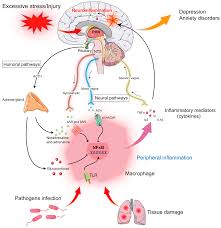Breakthrough Study on Amygdala Cell Clusters Offers Hope for Targeted Treatments of Anxiety and Depression

Researchers at the University of California, Davis, have made significant strides in understanding the amygdala, a brain structure pivotal for processing emotions, especially fear. Their findings, published on October 30 in the American Journal of Psychiatry, reveal new clusters of cells with distinct gene expression patterns in the amygdala of both humans and non-human primates. This research holds promise for developing targeted treatments for anxiety and depression, disorders that affect millions worldwide.
Drew Fox, associate professor in the UC Davis Department of Psychology and senior author of the study, emphasized the importance of the amygdala in emotional processing. While variations in the size or structure of the amygdala have been linked to anxiety and depression, Fox notes that these factors do not reliably predict emotional issues. Recent research in rodents suggests that specific subregions of the amygdala contain various cell types with distinct and sometimes opposing functions, indicating that disorders may arise from alterations in these specific cell types.
To bridge the knowledge gap regarding cell types in the primate amygdala, graduate student Shawn Kamboj spearheaded a collaboration between Fox’s team and Professor Cynthia Schumann’s lab at the UC Davis School of Medicine. They utilized single-cell RNA sequencing to analyze samples from human and rhesus macaque brains, identifying and categorizing cell types based on their gene expression. This innovative approach allows researchers to better relate findings across species and potentially identify new treatment targets.
One key finding was the identification of cells expressing the gene FOXP2 in both humans and macaques. These cells, located on the edges of the amygdala, are known as intercalated cells, which have been shown to act as "gatekeepers" for signal traffic in the amygdala in rodents. This discovery suggests that intercalated cells could be a vital avenue for developing treatments for anxiety and related disorders.
The study also highlighted both similarities and differences in cell types between humans and non-human primates, enhancing understanding of how animal models relate to human psychopathology. For instance, the FOXP2-expressing cells also showed expression of the Neuropeptide FF Receptor 2 (NPFFR2), a receptor that could be targeted by pharmacological treatments. This insight could guide the development of new therapeutic strategies that activate the NPFFR2 pathway to address anxiety-related disorders.
Anxiety manifests in various ways, and a deeper understanding of the involved cell types could help identify "chokepoints" that affect a large number of individuals suffering from extreme anxiety. Fox remarked, "If we're developing a drug to target the amygdala, we want to know which cell type we are targeting."
The research was supported by the California National Primate Research Center and grants from the NIH and the Simons Foundation. Additional authors of the study include Erin Carlson, Kari Hanson, Bradley Ander, Julie Fudge, Melissa Bauman, and Karl Murray.
Story Source:
Materials provided by University of California - Davis. The original text of this story is licensed under a Creative Commons License. Note: Content may be edited for style and length.
Journal Reference:
- Shawn Kamboj, Erin L. Carlson, Bradley P. Ander, Kari L. Hanson, Karl D. Murray, Julie L. Fudge, Melissa D. Bauman, Cynthia M. Schumann, Andrew S. Fox. Translational Insights From Cell Type Variation Across Amygdala Subnuclei in Rhesus Monkeys and Humans. American Journal of Psychiatry, 2024; DOI: 10.1176/appi.ajp.20230602

0 Comments